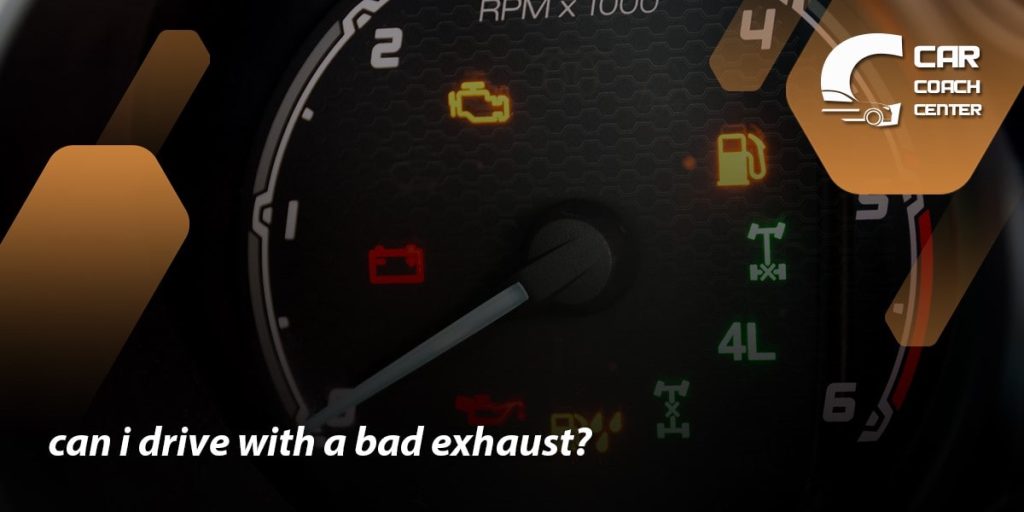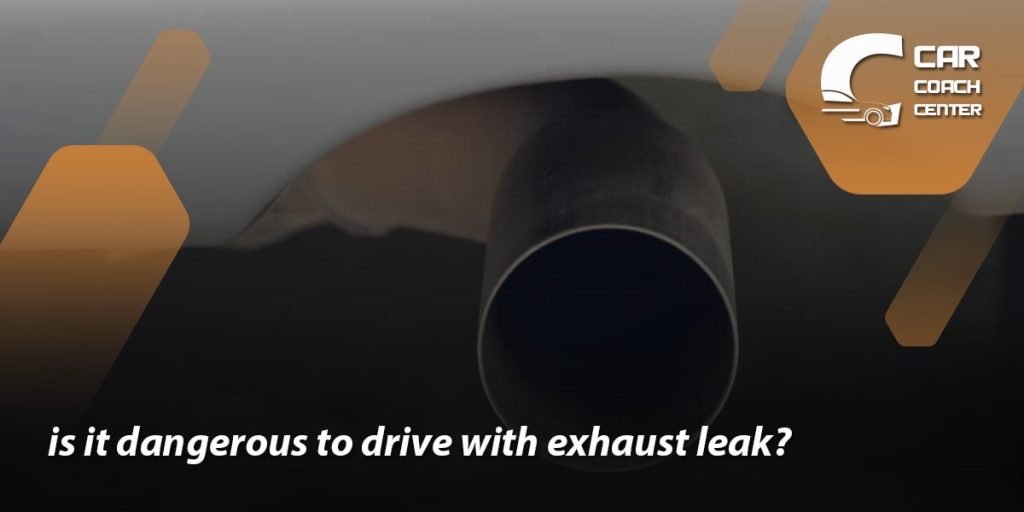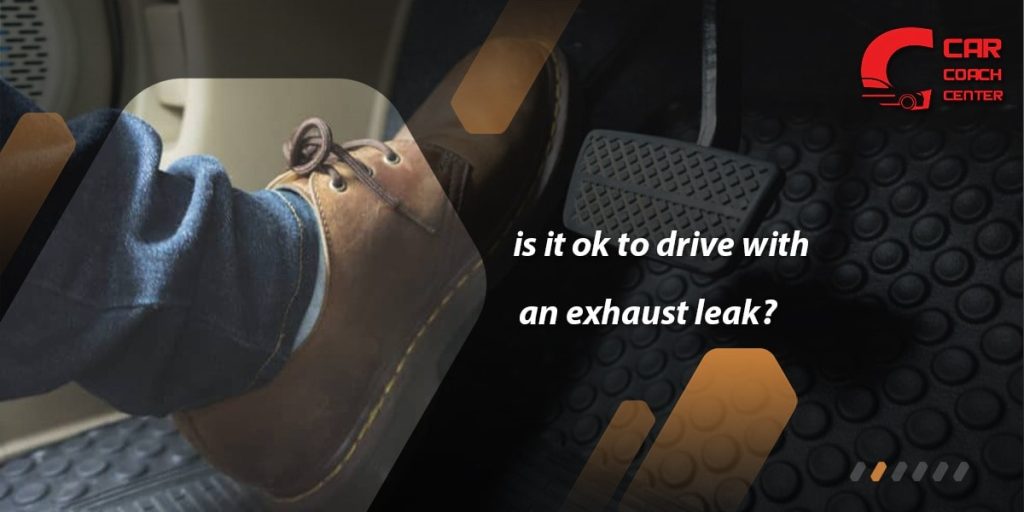Can You Drive With an Exhaust Leak
Imagine cruising down the open road, wind in your hair, and a sense of freedom enveloping you. Suddenly, an unusual rumbling sound disrupts the harmony, accompanied by a pungent smell that hints at trouble under the hood. You suspect an exhaust leak, but the question lingers: Can you continue driving? Your vehicle’s exhaust system’s integrity is crucial for performance and safety.
This article delves into the world of exhaust leaks, exploring the signs, risks, and implications of driving with this issue. Understanding the potential hazards involved is essential for every responsible driver. Whether you’re a seasoned automobile enthusiast or a casual driver, join us as we unravel the master exhaust leaks’ mysteries and insights into temporary fixes and long-term solutions.

By the end, you’ll be equipped with the knowledge to make informed decisions about addressing this issue and maintaining the health of your vehicle’s exhaust system. So, fasten your seatbelts and embark on this journey to explore the impact of exhaust leaks on your driving experience.
Signs and Symptoms: How to Detect an Exhaust Leak
A well-functioning exhaust system is vital for the optimal performance of your vehicle. However, even minor leaks can have a significant impact on both your driving experience and your health. It’s crucial to be aware of the signs and symptoms that indicate the presence of an exhaust leak. By recognizing these indicators early on, you can take the necessary steps to address the issue promptly. Here are some key signs to watch out for:
Unusual Engine Noise
One of the primary indicators of an exhaust leak is a distinct hissing, popping, or sputtering sound from the engine compartment. This noise may be more noticeable during acceleration or when the engine is under load.
Foul Odors
If you detect a strong smell of exhaust fumes inside or outside the vehicle, it indicates an exhaust leak. Please pay attention to any lingering or unusual smells, as they can be harmful when inhaled.
Decreased Fuel Efficiency
A sudden drop in fuel efficiency could be linked to an exhaust leak. When there’s a breach in the system, the engine may work harder to compensate, resulting in increased fuel consumption.
Vibrations
An exhaust leak can cause vibrations, particularly in the steering wheel, gas pedal, or entire vehicle. These vibrations are often more pronounced during idling or revving the engine.
Visible Damage
Inspect the exhaust system for any visible signs of damage, such as holes, cracks, or loose connections. Rust or black soot near joints or pipe connections can also indicate an exhaust leak.
Check Engine Light
Some caAneak can sometimes trigger the e-check engine light on your dashboard. If the light remains illuminated or flashes intermittently, it’s essential to have your vehicle inspected by a professional.
The Dangers Unveiled: Understanding the Risks of Driving with an Exhaust Leak
Driving with an exhaust leak may seem like a minor inconvenience, but the risks associated with this issue should not be taken lightly. It’s crucial to comprehend the potential dangers to your vehicle and your well-being. Let’s explore the risks of driving with an exhaust leak:
Carbon Monoxide Poisoning
The most significant risk of an exhaust leak is the release of carbon monoxide (CO) gas into your vehicle’s cabin. Carbon monoxide is an odorless, colorless gas that can be fatal when inhaled in high concentrations. Symptoms of carbon monoxide poisoning include headaches, dizziness, nausea, and even loss of consciousness. Prolonged exposure to this toxic gas can have severe health consequences.
Impaired Judgement and Focus
Carbon monoxide exposure can impair cognitive function, leading to drowsiness, confusion, and poor concentration. This can severely impact your ability to make quick decisions on the road and react to potential hazards, increasing the risk of accidents.
Fire Hazard
An exhaust leak near any flammable materials, such as oil or debris, can pose a fire hazard. The hot gases from the leak can ignite these substances, resulting in a potentially dangerous situation.
Engine Damage
An exhaust leak can impact the back pressure in the exhaust system, causing the engine to work harder. This increased strain can lead to overheating and potential engine damage, which can be costly to repair.
Environmental Impact
A leaking exhaust system emits harmful pollutants into the environment, contributing to air pollution. This affects the quality of the air we breathe and contributes to climate change.

Effects on Vehicle Performance: How an Exhaust Leak Can Impact Your Driving Experience
An exhaust leak may initially seem minor, but it can significantly affect your vehicle’s performance. The exhaust system maintains engine efficiency, reduces noise levels, and maximizes power output. Here are some ways an exhaust leak can impact your driving experience:
Reduced Power and Acceleration
An exhaust leak disrupts the back pressure in the exhaust system, leading to a loss of engine power. This can result in reduced acceleration and overall performance. You may notice a decreased responsiveness when you press the accelerator, making it harder to merge onto highways or pass other vehicles.
Increased Engine Noise
The exhaust system is designed to muffle and control the noise produced by the engine. When there is a leak, the sound waves are no longer contained, increasing engine noise. You may notice a louder and more aggressive exhaust note, which can be irritating and disrupt your driving experience.
Poor Fuel Efficiency
A leak in the exhaust system can disrupt the proper air-fuel mixture, causing the engine to run inefficiently. This leads to increased fuel consumption and reduced fuel efficiency. Over time, this can translate into more frequent visits to the gas station and higher fuel expenses.
Engine Overheating
Back pressure is essential for maintaining optimal engine temperature. An exhaust leak disrupts this balance, leading to increased heat build-up in the engine compartment. Over time, the excessive heat can cause dam damage to engine components and causes heating, potentially leading to engine failure.
Check Engine Light Activation
Modern vehicles are equipped with onboard diagnostic systems that monitor the performance of various components, including the exhaust system. In the presence of an exhaust leak, the system may detect abnormal readings and trigger the check engine light on your dashboard.
Environmental Impact
An exhaust leak can also increase emissions of harmful pollutants, such as carbon monoxide, nitrogen oxides, and hydrocarbons. This not only affects air quality andes to environmental pollution and climate change.
Addressing the Issue: DIY Fixes for Temporary Exhaust Leak Solutions
Discovering an exhaust leak in your vehicle can be concerning. Still, temporary do-it-yourself (DIY) fixes can help mitigate the issue until you can seek professional assistance. While these solutions are not permanent, they can provide a temporary remedy to reduce the leak’s impact. Here are a few DIY fixes for addressing an exhaust leak:
Exhaust Tape
Specialized exhaust repair tapes, such as heat-resistant aluminum or fiberglass tape, can be used to temporarily holes or gaps in the exhaust system temporary tape tightly around the affected area, ensuring it covers the leak entirely. The tape’s heat-resistant properties allow it to withstand high temperatures and hold up under the stress of exhaust gases.

Epoxy Putty
Epoxy putty, also known as exhaust repair paste or muffler cement, can seal small cracks or leaks. It is a two-part adhesive that, when mixed, forms a durable compound. Apply the putty to the affected area and mold it to cover the leak. Let it cure as per the manufacturer’s instructions before starting the vehicle.
Hose Clamps and Metal Patch
For largerYourarily seal the leak using hose clamps and a metal patch. Cut a pi for larger holes or damaged sections of sheet metal or aluminum can to cover the hole, place it over the leak, and secure it using hose clamps. Make sure the patch is tight, and the clamps are properly fastened.
Muffler Bandage
Muffler bandages or exhaust repair wraps are heat-resistant materials that can be wrapped around the affected area to seal the leak temporarily. Follow the manufacturer’s instructions to apply the bandage tightly and ensure it covers the leak completely.
Seeking Professional Help: Why You Should Consult a Mechanic for Exhaust Leak Repairs
While temporary DIY fixes can provide a temporary solution for exhaust leaks, it is crucconsultingional mechanic for a permanent repair. Here are is crucial the reasons why seeking professional help is essential:
Expert Diagnosis
Professional mechanics have the knowledge and experience to accurately diagnose the exact exhaust leaks and the location of ex-specialized equipment, such as smoke machines and diagnostic tools, to identify the leak’s source and assess the exhaust system’s overall condition.
Comprehensive Repairs
Exhaust systems are complex and interconnected, consisting of components such as pipes, mufflers, catalytic converters, and sensors. A professional mechanic can provide a comprehensive repair solution that addresses the underlying issues in the exhaust system, ensuring all damaged or worn-out parts are properly replaced or repaired.
Quality Repairs and Parts
Professional mechanics can access high-quality replacement parts and materials that meet manufacturer specifications. They can ensure that the repairs are done using reliable and durable components, minimizing the chances of future leaks or failures.
Warranty and Guarantees
Reputable repair shops often offer warranties or guarantees on their artistry and the parts they use. This gives you peace of mind, knowing that you can return to the mechanic for further assistance if any issues arise after the repair.
Safety Considerations
Exhaust leaks pose potential risks to your health and safety due to carbon monoxide exposure. Professional mechanics prioritize your safety and take the necessary precautions to address the leak properly, minimizing the risk of further harm.
Preventing Further Damage
A professional repair not only fixes the current exhaust leak but also prevents additional damage to other components exhaust system components. The issue promptly and comprehensively, you can avoid more extensive and costly repairs in the future.
Compliance with Regulations
Exhaust systems are subject to regulatory standards, such as emission regulations. Professional mechanics are familiar with these regulations and can ensure that the repair work complies with the required standards, helping you maintain legal compliance.

Preventing Future Leaks: Maintenance Tips to Keep Your Exhaust System in Optimal Condition
Maintaining the health of your vehicle’s exhaust system is crucial for preventing future leaks and ensuring optimal performance. Here are some maintenance tips to help you keep your exhaust system in excellent condition:
Regular Inspections
Schedule periodic inspections of your exhaust system, especially if you notice unusual noises, odors, or performance issues. A professional mechanic can assess the system for leaks, cracks, loose connections, or signs of wear. Early detection of potential issues can prevent them from developing into major leaks.
Avoid Off-Road Driving
Rough terrains, such as off-road trails or unpaved roads, can expose your exhaust system to excessive vibrations and impacts. These conditions increase the likelihood of damage to the pipes, mufflers, and other components. Whenever pAvoidn such conditions to minimize the risk of leaks.
Chec whenever possiblek for Rust and Corrosion
Rust and corrosion weaken the integrity of the exhaust system, making it more susceptible to leaks. Regularly inspect the pipes, mufflers, and other components for any signs of rust or corrosion. If you notice significant corrosion, consult a mechanic for proper evaluation and potential replacement of affected parts.
Maintain Proper Engine Operation
A poorly running engine can put antistress the exhaust system more to premature wear and potential leaks. Follow the manufacturer’s recommended maintenance schedule, including regular oil changes, spark plug replacements, and air filter cleanings. A well-maintained engine ensures optimal combustion and reduces the strain on the exhaust system.
Drive Cautiously
Avoid excessive acceleration, abrupt stops, and aggressive driving habits. These driving behaviors can increase the stress on the exhaust system, potentially causing damage or loosening connections. Drive with care, and be mindful of speed bumps, potholes, and other road hazards that can impact the underside of your vehicle.
Keep the Exhaust System Clean
Regularly clean the exterior of the exhaust system to remove dirt, debris, and road salt. These contaminants can accelerate corrosion and compromise the system’s integrity. Use a soft brush or cloth and mild soap to clean the pipes and muffler. Avoid abrasive cleaners or brushes that can cause scratches.
conclusion
In conclusion, understanding the implications of driving with an exhaust leak is crucial for every responsible vehicle owner. The signs and symptoms, risks, and effects on vehicle performance discussed in this article shed light on the importance of addressing exhaust leaks promptly. While temporary DIY fixes can provide temporary relief, seeking professional help for a comprehensive and lasting repair is strongly recommended.
Car Couch Center (carcouchcenter.com) advises consulting a professional mechanic who can accurately diagnose the issue, ensure high-quality repairs, and prioritize your safety. Additionally, maintaining the health of your exhaust system through regular inspections, cautious driving, and proper engine maintenance can help prevent future leaks.
By being proactive and taking the necessary steps to address exhaust leaks, you can maintain optimal vehicle performance, minimize health risks, and enjoy a smoother driving experience. Remember, your vehicle’s well-being and safety should always be a top priority.
Can I drive with an exhaust leak?
It is not Drivingxhaust leak due to theis not recommended risks involved, such as carbon monoxide exposure and potential engine damage.
How can I detect an exhaust leak?
Signs of an exhaust leak include unusual engine noises, foul odors, decreased fuel efficiency, vibrations, visible damage, and the activation of the check engine light.
Are temporary DIY fixes for exhaust leaks effective?
Temporary DIY fixes like exhaust tape, epoxy putty, and muffler bandages can provide a temporary solution but should be followed up with professional repairs for a lasting fix.


